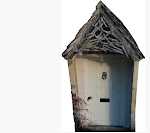 Name:
Name: In the old tales he is most often referred to simply as 'the wolf'. It was during the recording of Disney's famous 1933 song (which you can listen to further down) that he acquired the 'Big Bad'. He was originally going to be called 'The Big Old Wolf' but
reportedly Walt decided 'The Big Bad Wolf' scanned better.
Age: Impossible to figure out—but here's what we do know:
Fenir, one of the first bad wolves, can be found in Norse mythology (he's mentioned in the
Poetic Edda which was compiled from oral sources in the 13th century). The wolf and werewolf are thought to have been popular figures in oral folk tales for centuries—
The Grandmother, which was collected in 1870, is representative of this tradition. The wolf, as we are perhaps most familiar with him, appears in three distinct fairy tales in the European literary tradition:
Little Red Riding Hood: the
first literary version, by Charles Perrault, was published in 1697. In this version the wolf gets exactly what he wants and we're warned of wolves 'who are charming, quiet, polite, unassuming, complacent, and sweet, who pursue young women at home and in the street' (or as Grandmother so succinctly puts it in the film
The Company of Wolves 'The worst kind of wolf is hairy on the inside'). The Grimms included their version of the tale, Little Red Cap, in every edition of their
Children's and Household Tales; you can read the
1812 version, or the final
1857 version online. It was the Grimms who introduced the woodsman and the nasty ending for the wolf.
The Wolf and the Seven Young Kids: first published by the Grimms in
Children's and Household Tales in 1812, the tale includes a very similar fate for the wolf.
The Story of the Three Little Pigs: first collected by James Orchard Haliwell in
The Nursery Rhymes of England in its first edition of 1842. This was the source for Joseph Jacob's more famous
1890 version.
Location: Wolf and werewolf tales were common throughout Europe, particularly in France, but not so much here in Britain where unfortunately we'd managed to exterminate wolves by the 17th century—we have lots of
Last Wolf tales instead.
Relationship Status: You might think a wolf who went round either scoffing small pigs, baby goats, or young girls and/or their Grandmothers might find it hard to get a date—but that's not always the case—whether it's Red herself that takes a fancy to him, as in Angela Carter's 'The Company of Wolves' (from
The Bloody Chamber) and Carol Ann Duffy's 'Little Red-Cap' (from
The World's Wife); or Grandma, as in the original ending to Tex Avery's 1943 cartoon
Red Hot Riding Hood (which was cut because it was
thought to be too close to bestiality), and in this 1931 cartoon:
taken from the Internet ArchiveWho's afraid of the Big Bad Wolf?taken from the Internet ArchiveAs we've already seen not everybody, and although the wolf in the older tales is always bad there are a lot of reformed versions out there, from Bigby (sherrif, and son of the North Wind—from whom he inherited his Huff 'n Puff) in the unbelievably good
Fables series; to the cross-dressing, rather lazy wolf in the
Shrek films.
Some other places you'll find him lurking online:An 1866 verse version of
Little Red Riding Hood by Tom Hood, which includes the illustrations by Gustave Doré.
Little Red Riding Hood—A 1921 version with lovely illustrations by Jennie Harbour.
Roald Dahl's wonderful
Little Red Riding Hood and the WolfAn illustrated copy of
The Story of the Three Little Pigs, from 1904.
A Wolf's Lament, by M. Lynn Johnson— a great story that featured in Issue 8 of
Cabinet Des FéesThe wolf in myths, legends and stories at
Wolf Country.
A collection of
Werewolf Legends from Germany, translated by D.L. Ashliman.
The Bad Wolf site, created by the BBC to accompany the 2005 series of
Doctor Who throughout which the ominous sounding 'Bad Wolf' message was scattered.
Any more sitings of the wolf online? Feel free to add links using the comments function below.
The wolf image at the top of the post is a detail from an illustration by Gustave Doré.
 Firstly, I want to welcome the newly expanded New Fairy Tales team:
Firstly, I want to welcome the newly expanded New Fairy Tales team:








